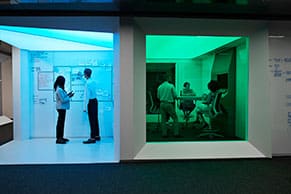Enterprise resource planning (ERP) solutions have matured and expanded their reach to support most business functions, from back-end processes, like accounting, human resources, procurement and manufacturing, to front-office functions, such as sales force automation, marketing automation and ecommerce. Businesses rely on ERP to not only cut costs by eliminating redundant processes and automating mundane tasks, but also to provide employees access to critical information to make better decisions, faster. It’s no wonder that 1.4 million companies are projected to spend $183 billion on ERP over the next year.
As companies increasingly rely on ERP to run their businesses, these systems continue to evolve to incorporate new technologies and support a broader range of functions. In this article, we’ll cover eight major trends to keep an eye on in 2025 and beyond.
Key Takeaways
- Businesses continue moving to cloud ERP.
- Artificial intelligence (AI), and specifically machine learning (ML), help optimize more business processes, provide new insights and create personalized customer interactions.
- ERP is further integrating with other technologies, such as internet of things (IoT) devices and social media, to automate even more and provide greater visibility and a better customer experience.
- Solutions that support remote work via mobile devices have become critical as organizations increasingly rely on distributed workforces.
8 ERP Trends for 2025 and Beyond
1. Cloud ERP
Historically, many organizations used on-premises ERP applications and were reluctant to entrust core business applications to the cloud, but that’s changing rapidly. Businesses are adopting cloud ERP to take advantage of a simpler deployment, lower costs, elasticity (i.e., the ability to only use the necessary resources at any given time), new functionality, less need for internal IT resources, and the ability to easily add users and functions to accommodate business growth. In fact, one report shows the cloud ERP market is expected to grow from $72.2 billion in 2023 to $130.5 billion by 2028.
And, as many businesses adopt more decentralized models — whether geographically or functionally — cloud ERP will play a role in supporting edge computing, in which data processing occurs closer to the location where data is generated, rather than being sent to distant centralized data centers to be processed. This increases speed, security and reliability, regardless of where employees are located.
2. Two-Tier ERP
Historically, many companies tried to deploy a single ERP system for both the headquarters and all regional offices and subsidiaries. But in practice, that approach was often costly and extremely challenging to implement; subsidiaries often had specialized requirements, didn’t need the full functionality of the corporate system and struggled with the one-size-fits-all approach.
That’s why two-tier ERP remains a top ERP trend in 2025. Two-tier ERP is a strategy that enables organizations to leverage their investments in existing ERP systems at the corporate level (tier 1), while subsidiaries and divisions operate using a different ERP solution (tier 2), which is often cloud-based. Larger companies may continue to use their core ERP system for financials and other core processes, while smaller business units turn to solutions that address their specialized needs. The effectiveness of this approach depends, in part, on the ability to exchange data between the tiers — more and more tier 2 cloud solutions are including built-in capabilities for integration with corporate ERP systems, while advanced APIs are simplifying the integration process to facilitate real-time data flows and unified enterprisewide analytics.
This approach offers a number of benefits. It’s often less costly than retrofitting the corporate ERP system to work for the entire business. A tier 2 solution may be simpler to implement and provide subsidiaries with more flexibility to respond to changing business conditions. In addition, the two-tiered approach may be better suited for organizations in high-growth mode. As Gartner puts it, large organizations should “assess whether a two-tier ERP strategy would offer more business benefit than a single-tier one, especially by modernizing small, potentially fast-growing business units.”
3. Digital Transformation
A continuous process rather than a one-time initiative, digital transformation remains a key focus in 2025. Modern ERP systems play a key role in this transformation by integrating digital technology into all business functions to improve daily operations, boost revenue and increase competitiveness — all while increasing employee productivity and improving customer service and communication.
Since an ERP suite typically touches most areas of a company, it’s a logical place to pursue or continue with digital transformation. As highlighted in several of the trends below, ERP systems are increasingly incorporating AI, IoT and advanced analytics to not support and actively drive business innovation, efficiency and align companies with the strategic, value-driven goals of digital transformation.
4. Other Technology Integrated With ERP
While modern ERP is a main element in a company’s digital transformation, it’s only part of a bigger investment in technology. Companies are integrating their business applications with other new technologies to improve core processes and operational efficiency. For example, integration with IoT capabilities is becoming increasingly sophisticated. Manufacturers might use ERP systems integrated with IoT sensors to monitor equipment performance in real time, making them capable of predicting maintenance needs before a breakdown halts operations. Similarly, in logistics, ERP systems linked with automated robotic warehouse solutions can optimize inventory management and delivery processes.
Integration with ecommerce platforms also remains crucial, especially as businesses continue to expand their online presence. When integrated with ecommerce platforms, for instance, ERP systems can support the end-to-end order fulfillment process through streamlined order processing, inventory updates, payment management and shipping.
5. Personalization
Historically, ERP platforms with complex scripting languages were difficult to customize to the specialized needs of each business. But organizations can now take advantage of cloud ERP platforms designed for easier configuration —what analysts call “low-code” and “no-code” platforms. These tools empower companies and their users to easily tailor the ERP system to their specific needs without extensive technical expertise.
The flexibility of modern ERP systems is also contributing to a growing range of ERP solutions tailored to the needs of specific industries. For example, in the healthcare sector, ERP systems are increasingly designed with modules that manage patient records, comply with health regulations and integrate with medical billing systems. This allows healthcare providers to focus more on patient care and less on administrative tasks.
As companies focus on delivering more personalized, relevant experiences to customers, they need ERP systems that can accommodate those needs with features like highly customizable dashboards. One emerging trend is the growing popularity of AI-based assistive and conversational user interfaces such as chatbots, which can interpret user voice or text input and respond to questions using customer and order information stored within the ERP.
6. AI-Powered Insights and Improvements
As of 2025, AI and ML capabilities are becoming core components of ERP systems — not just add-ons. Embedded within the ERP, these technologies work behind the scenes to help meet increased demand for personalization and improve a broad range of business processes. Today, more ERP vendors are not only including AI capabilities as standard features, but they are also advancing these capabilities to exploit the latest in AI technology, such as generative AI.
AI can deliver significant benefits for businesses, including:
More insights: As organizations gather more operational and customer data than ever before, they look to AI to deliver valuable business insights based on that information. Advanced AI technologies scan vast amounts of unstructured information, quickly identify patterns and predict various trends that wouldn’t be possible to spot with manual number crunching alone.
Improved processes: AI helps to automate and improve a whole range of processes. For example, consider a manufacturer that adopts a just-in-time inventory strategy, which aims to deliver components at the last possible moment to minimize inventory carrying costs. AI, in the form of ML, can optimize the supply delivery and labor schedules to increase productivity and lower costs. Furthermore, the advent of generative AI may soon reshape how businesses approach ERP system upgrades and migrations. According to one report, even early efforts to apply generative AI to tasks like cloud migration have suggested a 40% reduction in both time and investment. This is promising for companies hesitant to adopt ERP technology due to the perceived complexity and investment required for implementation.
7. Predictive Analytics
The hunger for AI-infused ERP highlights organizations’ increasing desire to mine their operational and customer data for new and relevant insights that will increase the top and bottom lines.
While it’s always been possible to analyze ERP data to reveal what happened in a business’s past, a focus in 2025 and beyond is using advanced predictive analytics to uncover and address what is likely to happen in the future. This data can be used to predict outcomes that help companies avoid potential issues and capitalize on emerging opportunities.
For example, software with ML capabilities can comb through a maintenance company’s vast data repository to gather pertinent information about appliance repairs to predict when breakdowns are likely to occur. The organization can use that data to optimize maintenance schedules so it services or replaces parts right before they cause problems for clients.
Predictive analytics is also expanding into areas like financial forecasting, demand planning and even human resources, where it can predict employee turnover and improve hiring processes.
8. Mobile ERP
ERP providers have offered mobile support for some time, and mobile apps are becoming the norm. ERP solutions are evolving to provide on-the-go access to critical business data, allowing employees to conduct both back-end and front-end tasks no matter where they are, from the warehouse floor to a retail checkout terminal to an airport. Mobile ERP can also encourage collaboration for dispersed workforces in different time zones.
Mobile ERP apps designed with a user-friendly interface can help users get work done when they’re not in front of a computer. Employees can complete tasks like expense reporting, call logging and time tracking, and they can view the status of critical workflows or approvals from their phones. Mobile ERP offers real-time data and insights and provides overall benefits, including always-on remote access, improved productivity, faster and more accurate data capture and increased agility.
4 ERP Predictions
Current and upcoming ERP trends are one thing, but what does the future have in store? Here’s a look at a few predictions for what ERP might entail in the future, near and far:
1. Autonomous Solutions
AI and ML technology are only advancing, making it likely that ERP systems will move toward greater autonomy. In practice, this could mean ERP systems will be capable of proactively managing business operations without human intervention. For example, ERPs may be able to automate even more complex decision-making processes, such as optimizing supply chain logistics or dynamically adjusting pricing strategies.
2. Blockchain Integration
Blockchain has been buzzing about for years, but the technology could increasingly be integrated into ERP systems to enhance transparency and security. This is particularly useful in supply chain management, as blockchain would allow for tamper-proof records of transactions and real-time tracking of goods and services across the globe. It’s also relevant for sustainability: Companies can use blockchain to create “green ledgers” that transparently track environmental data alongside or as part of traditional financial metrics.
3. Conversational AI
With the rise of virtual assistants and chatbots, ERP systems are likely to incorporate more conversational AI and voice interfaces. These technologies can make user interaction more intuitive and accessible, enabling users to perform tasks or retrieve information through natural language commands rather than keystrokes or clicks.
4. Open Standards
As businesses continue to digitize and adopt various software tools, an ERP’s ability to seamlessly connect with these platforms is essential. Designed to ensure that software and hardware products can work together seamlessly, open standards are likely to simplify integration and communication between disparate systems. This helps guarantee ERP solutions can easily share data and functionality across an increasingly complex digital landscape.
What’s Next? The Future of ERP
The transition to cloud ERP will continue to accelerate as companies realize it’s much easier to gain the speed and agility they need to compete in today’s marketplace if they shift ERP and its associated modules to the cloud. Those organizations that have already invested in cloud ERP will look for ways to further utilize the power of the cloud.
In the near term, organizations will also continue to focus on ensuring their ERP software is optimized for remote work. That includes providing more mobile ERP functionality, ensuring secure remote access, supporting remote training and increasing automation of workflows.
Another trend to watch: further expansion of ERP supply chain management capabilities to help protect the organization against supply chain disruptions or other rapid changes in global economic conditions.
As ABI Research Principal Analyst Michael Larner put it, “Supply chain orchestration requires software to be more than a system of record and provide risk analysis and run simulations, enabling manufacturers to understand and prepare for supply chain shocks.”
Stay Ahead of the Curve With NetSuite’s Leading-Edge Cloud ERP
If business success depends on adaptability and efficiency, NetSuite ERP is the answer. As the world’s most deployed cloud ERP, NetSuite simplifies complex business processes across multiple dimensions — from automated financial operations to optimized order management and supply chain dynamics — to position companies of all sizes at the leading edge of operational excellence.
For example, with its integrated AI capabilities, NetSuite can transform vast amounts of data into actionable insights that facilitate smarter decisions, faster. And with AI tools like NetSuite Bill Capture and Text Enhance, companies can further support productivity by automating invoice data entry, as well as the creation and refinement of content like purchase orders, sales emails, purchase orders and product descriptions.
Whether managing global operations across 200 countries and handling multiple currencies or running a growing operation out of California, NetSuite equips any company with the tools it needs to stay competitive and innovative.
ERP Trends FAQ
What is the future of the ERP industry?
The future of the ERP industry will likely be shaped by cloud-based systems, two-tier platforms, an increasing amount of personalization and customization, a proliferation of advanced AI systems, highly capable predictive analytics capabilities and a need for seamless integration between digital platforms.
What are the predictions about the future of the ERP market?
The ERP market is predicted to continue growing. With that growth could come more advanced capabilities and technologies, including:
- Autonomous solutions that proactively manage operations without human intervention.
- Blockchain integration that allows for transparent, tamper-proof records.
- Conversational AI tools that make user interaction more intuitive and accessible through voice interactions and natural language.
- Open standards, which can help ERPs seamlessly connect with various software tools and minimize incompatibility.
Is the ERP market growing?
Yes, the ERP market continues to grow as businesses continue to digitize and recognize a need for a solution that will integrate data and streamline end-to-end business processes. One report shows the cloud ERP market is expected to grow from $72.2 billion in 2023 to $130.5 billion by 2028.









